Muscarinic Modulation of Morphologically Identified Glycinergic Neurons in the Mouse PreBötzinger Complex
- PMID: 31998077
- PMCID: PMC6962194
- DOI: 10.3389/fncel.2019.00562
Muscarinic Modulation of Morphologically Identified Glycinergic Neurons in the Mouse PreBötzinger Complex
Abstract
The cholinergic system plays an essential role in central respiratory control, but the underlying mechanisms remain elusive. We used whole-cell recordings in brainstem slices from juvenile mice expressing enhanced green fluorescent protein (EGFP) under the control of the glycine transporter type 2 (GlyT2) promoter, to examine muscarinic modulation of morphologically identified glycinergic neurons in the preBötzinger complex (preBötC), an area critical for central inspiratory rhythm generation. Biocytin-filled reconstruction of glycinergic neurons revealed that the majority of them had few primary dendrites and had axons arborized within their own dendritic field. Few glycinergic neurons had axon collaterals extended towards the premotor/motor areas or ran towards the contralateral preBötC, and had more primary dendrites and more compact dendritic trees. Spontaneously active glycinergic neurons fired regular spikes, or less frequently in a "burst-like" pattern at physiological potassium concentration. Muscarine suppressed firing in the majority of regular spiking neurons via M2 receptor activation while enhancing the remaining neurons through M1 receptors. Interestingly, rhythmic bursting was augmented by muscarine in a small group of glycinergic neurons. In contrast to its heterogeneous modulation of glycinergic neuronal excitability, muscarine generally depressed inhibitory and excitatory synaptic inputs onto both glycinergic and non-glycinergic preBötC neurons, with a stronger effect on inhibitory input. Notably, presynaptic muscarinic attenuation of excitatory synaptic input was dependent on M1 receptors in glycinergic neurons and on M2 receptors in non-glycinergic neurons. Additional field potential recordings of excitatory synaptic potentials in the M2 receptor knockout mice indicate that glycinergic and non-glycinergic neurons contribute equally to the general suppression by muscarine of excitatory activity in preBötC circuits. In conclusion, our data show that preBötC glycinergic neurons are morphologically heterogeneous, and differ in the properties of synaptic transmission and muscarinic modulation in comparison to non-glycinergic neurons. The dominant and cell-type-specific muscarinic inhibition of synaptic neurotransmission and spiking may contribute to central respiratory disturbances in high cholinergic states.
Keywords: glycine; inhibitory neurotransmission; morphometric analysis; muscarinic acetylcholine receptors; preBötzinger complex.
Copyright © 2020 Zheng, Nixdorf-Bergweiler, Edelmann, van Brederode and Alzheimer.
Figures
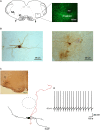
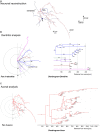
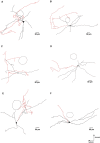
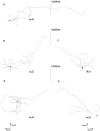
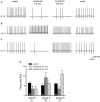
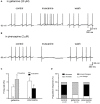
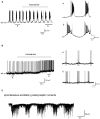


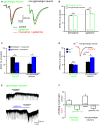


Similar articles
-
Glycinergic pacemaker neurons in preBötzinger complex of neonatal mouse.J Neurosci. 2010 Mar 10;30(10):3634-9. doi: 10.1523/JNEUROSCI.3040-09.2010. J Neurosci. 2010. PMID: 20219997 Free PMC article.
-
Cell Type-Dependent Activation Sequence During Rhythmic Bursting in the PreBötzinger Complex in Respiratory Rhythmic Slices From Mice.Front Physiol. 2018 Sep 3;9:1219. doi: 10.3389/fphys.2018.01219. eCollection 2018. Front Physiol. 2018. PMID: 30233397 Free PMC article.
-
Pre- and postsynaptic modulation of glycinergic and gabaergic transmission by muscarinic receptors on rat hypoglossal motoneurons in vitro.Neuroscience. 2005;130(3):783-95. doi: 10.1016/j.neuroscience.2004.09.046. Neuroscience. 2005. PMID: 15590160
-
Glycinergic transmission: glycine transporter GlyT2 in neuronal pathologies.Neuronal Signal. 2016 Dec 22;1(1):NS20160009. doi: 10.1042/NS20160009. eCollection 2017 Feb. Neuronal Signal. 2016. PMID: 32714574 Free PMC article. Review.
-
Respiratory rhythm generation and pattern formation: oscillators and network mechanisms.J Integr Neurosci. 2019 Dec 30;18(4):481-517. doi: 10.31083/j.jin.2019.04.188. J Integr Neurosci. 2019. PMID: 31912709 Review.
Cited by
-
Mechanisms of Organophosphate Toxicity and the Role of Acetylcholinesterase Inhibition.Toxics. 2023 Oct 18;11(10):866. doi: 10.3390/toxics11100866. Toxics. 2023. PMID: 37888716 Free PMC article. Review.
-
Cholinergic modulation of upper airway control: maturational changes and mechanisms at cellular and synaptic levels.J Neurophysiol. 2025 Jan 1;133(1):46-59. doi: 10.1152/jn.00165.2024. Epub 2024 Nov 28. J Neurophysiol. 2025. PMID: 39607299 Free PMC article. Review.
-
Impaired Presynaptic Function Contributes Significantly to the Pathology of Glycine Receptor Autoantibodies.Neurol Neuroimmunol Neuroinflamm. 2025 Mar;12(2):e200364. doi: 10.1212/NXI.0000000000200364. Epub 2025 Jan 16. Neurol Neuroimmunol Neuroinflamm. 2025. PMID: 39819053 Free PMC article.
References
LinkOut - more resources
Full Text Sources
Molecular Biology Databases
Miscellaneous

